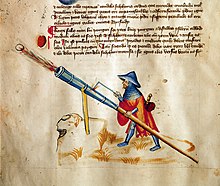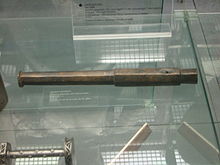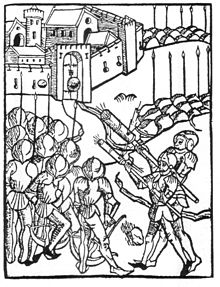Hand tube
The hand tube (also hand , rod or blunderbuss , short version Faust pipe , fist-box ; special versions of fire or ball lance , organ box , standpipe ) was the first handgun , ie a weapon that could be transported by one man and fired. The development of hand pipes began about the same time as the first fire guns of the artillery : bombard , mortars , Feldschlange , cannon .
history


There is no reliable information about the place and time of the invention of hand tubes. There are some written references and a few originals, most of which are not definitely dated. A bronze barrel from the Chinese province of Heilongjiang can be addressed as currently the oldest handgun , as this object could be dated to the 1280s on the basis of the bronze equipment found, so that a Chinese origin of the handguns is highly probable. Written references to hand pipes have been handed down from Italy via Germany to Flanders . The oldest reliably datable European hand pipe was found in Tannenberg Castle and dates from 1399 (see photo).
In Europe , the hand pipe remained in use until around 1520, before the arquebus took its place. In the Far East (especially in China ) hand tubes were used well into the 19th century.
Construction and handling
Hand tubes were initially cast from bronze . Only with the development of better steel were hand tubes made of iron. As ammunition , lead bullets were fired from the start - in contrast to the large guns, in which incendiary arrows and stone bullets were also initially used.
The pipe length varied between about 190 and 600 mm. The caliber ranged from approximately 12 to 36 mm, with the 35 mm caliber prevailing until the beginning of the 15th century. The weight of a hand tube was between 1.5 and 15 kg for siege models . Many hand tubes had a two-part barrel, in the front part the flight for receiving the projectile and behind, with a smaller caliber, the chamber for receiving the powder charge.
For easier handling, the hand tubes were attached to wooden poles about 600 to 2000 mm in length. Larger and heavier hand tubes were fired with the help of a support device (wooden gun fork, castle wall). Sometimes a second man had to assist with aiming the gun. Light hand tubes were placed under the arm (like a lance ) or detonated from the shoulder (like a modern bazooka ). Because of the large recoil, it was unusual to touch the shoulder.
The bulk of the hand pipes were muzzle-loading , although with breech-loading models were experimented. In all variants, the shooter ignited the powder charge with a fuse that burned (on both sides). Since the middle of the 15th century, he has been guiding this directly by hand to the open ignition hole using a matchlock in early models .
Ranges, use in combat
Despite a maximum range of around 300 m, hand tubes were only effective over short distances because aiming is difficult. Up to a distance of 100 m, the projectile of a handpipe was able to penetrate knight armor .
One person could also be fatally hit at 100 m. Disadvantages were the cumbersome handling, the resulting low firing frequency and the susceptibility of the powder to wind and moisture. That is why the use of the hand pipe was less in open field battles than in sieges and ambushes.
Tactical disadvantages, strategic advantages
Although the hand tubes remained tactically inferior to the longbows and crossbows in terms of handling, accuracy and firing frequency (hand tube: 1 shot / minute; crossbow: 2 shots / minute; longbow: 12 shots / minute) , they nonetheless gained their place in the arsenals of medieval warfare . The reasons for this were the low production costs (20 times cheaper than a crossbow), the simple manufacture (possible within half a day) and the resulting easier mass production. In addition, the use only required a few days of shooting training: if necessary, large contingents of shooters could be recruited in a very short time, and they also received a lower pay than the longbow archers trained over many years .
Special versions and further developments
The multi-barreled organ barrel (4 to 10 tubes) was experimented with as early as the 15th century.
The transition to smaller calibers went hand in hand with the improvement of the black powder quality and optimized casting processes : the volume of the propellant charge could be reduced and the weight of the thick-walled hand tubes decreased. A further technical development was the hook box , which appeared in the 15th century , from which the arquebus and the musket emerged .
Mounted riflemen used the "short hand tube" since the middle of the 15th century. Approximately 250 mm long was fired handgun from a fixed to the saddle, foldable support fork. The fist pipe (hand rifle , mitten ; in the 16th / 17th century also a buffer ) retained its name long after it had long been provided with a wheel lock . This marked the transition to the modern pistol .
Problem with the source reading
In older sources, identical designations are often found for different types of hand tube; a standardized classification did not begin until the 16th century. A clear identification of described firearms is therefore often no longer possible today.
literature
- P. Sixl: Development and use of small arms . In: Association for historical weapons (Hrsg.): Journal for historical weapons . No. 1 . Burdach, Dresden 1897.
- P. Sixl: Development and use of small arms . In: Association for historical weapons (Hrsg.): Journal for historical weapons . No. 2 . Burdach, Dresden 1898.
- Sean McLachlan: Medieval Handgonnes. The first black powder infantry weapons . Osprey Publishing, Oxford 2010, ISBN 978-1-84908-155-9 (English).
Web links
- Handgonnes and Matchlocks: The History of Firearms to 1500. Retrieved January 2, 2011 .
- Ulrich Bretscher's Black Powder Page. Retrieved January 2, 2011 .
- The Danzig handgun (1350-1430). Royal Armories Leeds, accessed on July 1, 2017 (English, Die Danzigbüchse (1350-1430)).
Individual evidence
- ↑ Needham, Joseph: Science and Civilization in China: Military Technology: The Gunpowder Epic . tape 5 , no. 7 . Cambridge University Press, 1987, pp. 290-293 .
- ↑ Ain Mäesalu: Weapons in Otepää castle in 1396 . In: Castella Maris Baltici . No. V , 2003, ISBN 978-87-88509-25-0 , pp. 91-98 (English).


